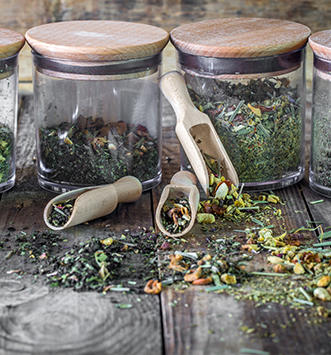
Tea storage is part of respecting the process of its harvesting and manufacturing. Many tea storage accessories help preserve the taste and aromas of flavored teas, fruit teas, plain teas, and herbal teas by protecting them from light, room temperature, and air. Maintaining tea freshness, whether organic, loose, or bagged, means improving its quality and paying special attention to its storage.
Tea infusion taste and aromas challenged by storage
Loose tea generally has a longer shelf life than tea bags, which contain broken leaves and lose their freshness more quickly. Similarly, the large leaves of loose teas keep longer than smaller, more fragile leaves.
Tea and herbal teas, loose or bagged: perishable goods?
Like coffee, teas and herbal teas are non-perishable products and can therefore be consumed beyond their best-before date (BBD, formerly DLUO). However, they may lose their freshness and aromas, and loose leaves may change color. Proper storage and storage conditions are key to preserving their character. The more oxidized a tea is, the longer it keeps.
The impact of oxidation on storage duration of classic teas, pu-erh, or matcha
The shelf life of tea or herbal tea differs depending on their oxidation level.
- Green teas, yellow teas (very rare) and some oolongs are lightly oxidized. The color of their leaves and their unique aroma can easily deteriorate. Their shelf life is 6 to 12 months.
- Black tea, white tea, rooibos, and several oolongs are oxidized teas and can be stored for approximately 18 months to three years.
- Pu-erh tea, roasted tea and oolong tea that are highly oxidized have no time limit for consumption. Pu-erh teas can even improve with time when stored in a well-ventilated and dry room.
- Matcha tea should be used within 1 to 2 months after opening and preferably stored in the refrigerator.
- Herbal teas should be kept in a cool, dry place.
Storing tea and herbal tea, bagged or loose, protected from the environment
Tea and herbal tea, and dry foods in general, can be subject to parasites, moisture, and mold. To avoid this deterioration, tea must be protected from several environmental elements.
- Air (oxygen) and moisture are tea's main enemies. The leaves don't spoil much, but they lose their aroma. The infusion of more delicate green teas will appear altered; black teas will become more bitter.
- Tea quickly absorbs odors from its surroundings; this is true for both storage and production (jasmine tea for example). Similarly, strong teas like Earl Grey or Lapsang Souchong should be stored separately from others.
- Teas are sensitive to room temperature and heat causes loss of tea aroma. For white tea, green tea, and matcha tea, storing in a refrigerator can be an alternative, but not all fridges can prevent high humidity levels.
- Any kind of light degrades tea leaves. Glass containers should therefore be avoided even if stored in a closed cupboard.
Tips for choosing storage accessories for loose and bagged tea
Preserving tea freshness means improving its quality by storing it in the right place and in the proper container to prevent oxygen, moisture, and light from entering.
The best products for storing loose tea
Loose teas are ideally stored in airtight and opaque containers. The most common are metal storage tins with double lids, but ceramic jars are also used. Choosing a container that matches the quantity of tea allows filling it while leaving minimal air space.
When buying a larger quantity, you can fill a small tin and keep the rest of the tea in its original packaging, removing the air and storing it in a larger container. Storage containers designed for tea are also used for ground or whole coffee beans. Besides metal tins, purple clay pots are also popular for long-term storage of oxidized teas, pu-erh, and heavily oxidized oolongs.
Tea bag storage
The best conditions for storing tea bags are the same as those for loose tea, namely protecting them from air, moisture, heat, and odors. If you have different types of tea bags, it's advisable not to store them together so that aromas and flavors don't mix, except for lightly scented teas or a limited number of varieties. Tea bags sold in cardboard packaging should preferably be transferred to an airtight and opaque container. They can also be stored in a tea drawer or cabinet.
Tea storage and preparation are closely linked. Choosing a quality product, preferably organic, and appropriate containers to preserve it, following consumption periods, and taking care with infusions by selecting an appropriate teapot and respecting water quantity and temperature, are our tips for enjoying the perfect tea.
We recommend these other pages: